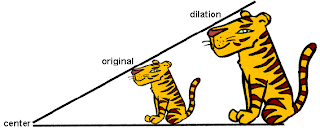And the answer is, not yet. :(
But don't worry, we are almost there! :D
There are only three more things that we must discuss about transformations, they are:
Glide Reflection, Orientation, and Isometry.
Lets start with glide reflection. What is glide reflection?
Glide reflection is the combination of a reflection in a line and a translation along that line.
 |
| Figure 1. This is an example of a glide reflection. |
 |
| Figure 2. This is how a glide reflection would be written out. |
IMPORTANT: Whenever you solve a glide reflection, order doesn't matter, it is not like compositions of transformations where you have to start with the second transformation. In glide reflection, you can start with any transformation first.
Okay now lets move on into isometry. So what is isometry?
Isometry, which is also referred to as isometric transformation, is a transformation of the plane that preserves length.
What does that mean? Well that means that a figure can be moved around on a plane and as long as the length of the sides of the figure are the same, then it is an isometry. Lets look at an example:
 |
| Figure 3. The original triangle has gone through various transformations but the length of the sides have not changed so it is an isometry. |
Now lets go over Orientation. What is orientation?
Orientation refers to the arrangement of points, relative to another.
When orientation is preserved it is called a direct isometry. This means that the order of the letters on the diagram go in the same clockwise or counterclockwise on the figure and its image.
 |
| Figure 4. A translation is an example of a direct isometry because the order of the letter on the figure and image go in the same counterclockwise direction (orientation preserved). |
An opposite isometry changes the order (clockwise turns into counterclockwise).
 |
| Figure 5. Reflection is an example of opposite isometry because the order of the letters went from counterclockwise to clockwise (orientation not preserved). |
NOW YOU TRY! :D
A triangle has vertices A(3,2), B(4,1) and C(4,3).
What are the coordinates of point B under a glide reflection:
 ?
?
 ?
?
1) (2,-4)
2) (4,0)
3) (4,-2)
4) (-4,2)










